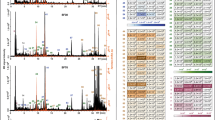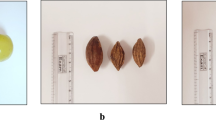Abstract
Gynura procumbens and Cleome gynandra are two herbs commonly used in Malaysia to treat various ailments and are also consumed as salads (ulam) and vegetables. The present study aims to evaluate the relationship between the chemical compositions of both herbs and their antioxidant and anti-inflammatory properties using nuclear magnetic resonance (NMR) metabolomics approach, which is being reported for the first time. Different ethanolic extracts of both herbs were tested for DPPH scavenging and inhibition of nitric oxide (NO) via RAW 264.7 macrophage cell induction. Principal component analysis (PCA) revealed a good separation between the extracts and the corresponding metabolites identified via 1H NMR spectroscopy. The 100% ethanolic extract from both herbs and 20% ethanolic extract of C. gynandra were found to have the best antioxidant and anti-inflammatory activities. Kaempferol, quercetin, caffeoylquinic, dicaffeoylquinic acids, gallic acid, mallic acid, citric acid, phenylalanine, and choline are among the metabolites that contributed to bioactivities. The partial least square (PLS) model for both herbs have an overall acceptable goodness of fit and predictive power, which further strengthens the validity of this study. The present study provides a preliminary reference for the selection of optimum extract and will shed some light on the potential use of G. procumbens and C. gynandra as a phytomedicinal preparation.


Similar content being viewed by others
References
Chaudhury A, Duvoor C, Reddy Dendi VS, Kraleti S, Chada A, Ravilla R, Marco A, Shekhawat NS, Montales MT, Kuriakose K, Sasapu A, Beebe A, Patil N, Musham CK, Lohani GP, Mirza W (2017) Clinical review of antidiabetic drugs: implications for type 2 diabetes mellitus management. Front Endocrinol 8:6–17. https://doi.org/10.3389/fendo.2017.0006
Liu H, Zhang X, Wu C, Wu H, Guo P, Xu X (2013) Anti-hyperlipidemic caffeoylquinic acids from the fruits of Pandanus tectorius Soland. J Appl Pharm Sci 3:016–019. https://doi.org/10.7324/JAPS.2013.3803
Hatzakis E (2019) Nuclear magnetic resonance (NMR) spectroscopy in food science: a comprehensive review. Compr Rev Food Sci F 18:189–220. https://doi.org/10.1111/1541-4337.12408
Liu NQ, Cao M, Frederich M, Choi YH, Verpoorte R, Van der Kooy F (2010) Metabolomic investigation of the ethnopharmacological use of Artemisia afra with NMR spectroscopy and multivariate data analysis. J Ethnopharmacol 128:230–235. https://doi.org/10.1016/j.jep.2010.01.020
Abdul-Hamid NA, Mediani A, Maulidiani M, Abas F, Ismail IS, Shaari K, Lajis NH (2016) Discrimination and nitric oxide inhibitory activity correlation of Ajwa dates from different grades and origin. Molecules 21:1423. https://doi.org/10.3390/molecules21111423
Iskander MN, Song Y, Coupar IM, Jiratchariyakul W (2002) Antiinflammatory screening of the medicinal plant Gynura procumbens. Plant Foods Hum Nutr 57:233–244. https://doi.org/10.1023/A:1021851230890
Rosidah Yam M, Sadikun A, Asmawi M (2008) Antioxidant potential of Gynura procumbens. Pharm Biol 46:616–625. https://doi.org/10.1080/13880200802179642
Zahra AA, Kadir FA, Mahmood AA, Al Hadi AA, Suzy SM, Sabri SZ, Latif II, Ketuly KA (2011) Acute toxicity study and wound healing potential of Gynura procumbens leaf extract in rats. J Med Plants Res 5:2551–2558
Kim J, Lee CW, Kim EK, Lee SJ, Park NH, Kim HS, Kim HK, Char K, Jang YP, Kim JW (2011) Inhibition effect of Gynura procumbens extract on UV-B-induced matrix-metalloproteinase expression in human dermal fibroblasts. J Ethnopharmacol 137:427–433. https://doi.org/10.1016/j.jep.2011.04.072
Mediani A, Abas F, Khatib A, Maulidiani H, Shaari K, Choi YH, Lajis NH (2012) 1H-NMR-based metabolomics approach to understanding the drying effects on the phytochemicals in Cosmos caudatus. Food Res Int 49:763–770. https://doi.org/10.1016/j.foodres.2012.09.022
Mediani A, Abas F, Khatib A, Tan CP, Ismail IS, Shaari K, Ismail A, Lajis NH (2015) Phytochemical and biological features of Phyllanthus niruri and Phyllanthus urinaria harvested at different growth stages revealed by 1H NMR-based metabolomics. Ind Crop Prod 77:602–613. https://doi.org/10.1016/j.indcrop.2015.09.036
Abdul-Hamid NA, Abas F, Ismail IS, Shaari K, Lajis NH (2015) Influence of different drying treatments and extraction solvents on the metabolite profile and nitric oxide inhibitory activity of Ajwa dates. J Food Sci 80:2603–2611. https://doi.org/10.1111/1750-3841.13084
Felhi S, Daoud A, Hajlaoui H, Mnafgui K, Gharsallah N, Kadri A (2017) Solvent extraction effects on phytochemical constituents profiles, antioxidant and antimicrobial activities and functional group analysis of Ecballium elaterium seeds and peels fruits. Food Sci Technol 37:483–492. https://doi.org/10.1590/1678-457x.23516
Tolonen A, Joustamo T, Mattlla S, Kämäräinen T, Jalonen J (2002) Identification of isomeric dicaffeoylquinic acids from Eleutheracoccus senticosus using HPLC-ESI/TOF/MS and H-NMR methods. Phytochem Anal 13:316–328. https://doi.org/10.1002/pca.663
Kim HK, Choi YH, Verpoorte R (2010) NMR-based metabolomic analysis of plants. Nat Protoc 5:536–549. https://doi.org/10.1038/nprot.2009.237
Ahmed FA, Khamis IMAE, Desoukey SY (2011) Flavonoids of Neotorularia aculeolata plant. J Pharm Nutr Sci 1:134–139. https://doi.org/10.6000/1927-5951.2011.01.02.08
Khoo LW, Mediani A, Zolkeflee NKZ, Leong SW, Ismail IS, Khatib A, Shaari K, Abas F (2015) Phytochemical diversity of Clinacanthus nutans extracts and their bioactivity correlations elucidated by NMR based metabolomics. Phytochem Lett 14:123–133. https://doi.org/10.1016/j.phytol.2015.09.015
Chen J, Mangelinckx S, Ma L, Wang Z, Li W, De Kimpe N (2014) Caffeoylquinic acid derivatives isolated from the aerial parts of Gynura divaricate and their yeast α-glucosidase and PTP1B inhibitory activity. Fitoterapia 99:1–6. https://doi.org/10.1016/j.fitote.2014.08.015
Msika P, Saunois A, Baudouin C, Leclere-Bienfait S, Debrock S (2013) Extract of the above-ground portions of Gynandropsis gynandra or Cleome gynandra, and cosmetic, dermatological or pharmaceutical compositions including same. World Intellectual Property Organization. https://patentscope.wipo.int/search
Lawal U, Maulidiani M, Shaari K, Ismail IS, Khatib A, Abas F (2017) Discrimination of Ipomoea aquatica cultivars and bioactivity correlations using NMR-based metabolomics approach. Plant Biosyst 151:833–843. https://doi.org/10.1080/11263504.2016.1211198
Abdul-Hamid NA, Maulidiani M, Mediani A, Yahya UII, Ismail IS, Tham CL, Shadid K, Abas F (2018) Physicochemical characteristics, nutritional composition, and phytochemical profiles of nine Algerian date palm fruit (Phoenix dactylifera L.) varieties. J Food Biochem 42:1–13. https://doi.org/10.1111/jfbc.12663
Kim J, Kim H, Choi H, Jo A, Kang H, Yun H, Im S, Choi C (2018) Anti-inflammatory effects of a Stauntonia hexaphylla fruit extract in lipopolysaccharide-activated RAW-264.7 macrophages and rats by carrageenan-induced hind paw swelling. Nutrients 10:110. https://doi.org/10.3390/nu10010110
Kadioglu O, Nass J, Saeed MEM, Schuler B, Efferth T (2015) Kaempferol is an anti-inflammatory compound with activity towards NF-ℵB pathway proteins. Anticancer Res 35:2645–2650
Dufour N, Rao RP (2011) Secondary metabolites and other small molecules as intercellular pathogenic signals. FEMS Microbiol Lett 314:10–17. https://doi.org/10.1111/j.1574-6968.2010.02154.x
Masek A, Chrzescijanska E, Zaborski M (2014) Estimation of the antioxidative properties of amino acids - an electrochemical approach. Int J Electrochem Sci 9:7904–7915
Lee JH, Park E, Jin HJ, Lee Y, Choi SJ, Lee GW, Chang PS, Paik HD (2017) Anti-inflammatory and anti-genotoxic activity of branched chain amino acids (BCAA) in lipopolysaccharide (LPS) stimulated RAW 264.7 macrophages. Food Sci Biotechnol 26:1371–1377. https://doi.org/10.1007/s10068-017-0165-4
Ma T, Liaset B, Hao Q, Petersen RK, Fjære E, Ngo HT, Lillefosse HH, Ringholm S, Sonne SB, Treebak JT, Pilegaard H, FrØyland L, Kristiansen K, Madsen L (2011) Sucrose counteracts the anti-inflammatory effect of fish oil in adipose tissue and increases obesity development in mice. PLoS One 6:1–7. https://doi.org/10.1371/journal.pone.0021647
Amin KA, Safwat GM, Srirajaskanthan R (2012) Dietary sugars: chemistry, analysis, function and effects. In: Preedy VR (ed) High sucrose diet and antioxidant defense, 3rd edn. RSC, Cambridge, pp 770–778
Kang MG, Lee HJ, Cho JY, Kim K, Yang SJ, Kim D (2016) Anti-inflammatory effects of sucrose-derived oligosaccharides produced by a constitutive mutant L. mesenteroides B-512FMCM dextransucrase in high fat diet-fed mice. Biochem Biophys Res Commun 47:350–355. https://doi.org/10.1016/j.bbrc.2016.06.102
Chung JY, Kim YS, Yoo SH (2017) Regulation of inflammation by sucrose isomer, turanose, in raw 264.7 cells. J Cancer Prev 22:195–201. https://doi.org/10.15430/JCP.2017.22.3.195
Yang Y, Zhang Z, Li S, Ye X, Li X, He K (2014) Synergy effects of herb extracts: pharmacokinetics and pharmacodynamic basis. Fitoterapia 92:133–147. https://doi.org/10.1016/j.fitote.2013.10.010
Acknowledgments
This study was financially supported by MARDI’s RMK-10 fund (P-RBH03-1001).
Author information
Authors and Affiliations
Corresponding author
Ethics declarations
Conflict of Interest
The authors declare that they have no conflict of interest.
Human and Animal Participants
This article does not contain any studies with human or animal subject.
Additional information
Publisher’s Note
Springer Nature remains neutral with regard to jurisdictional claims in published maps and institutional affiliations.
Electronic supplementary material
ESM 1
(DOCX 2.75 mb)
Rights and permissions
About this article
Cite this article
Chandradevan, M., Simoh, S., Mediani, A. et al. 1H NMR-Based Metabolomics Approach in Investigating the Chemical Profile, Antioxidant and Anti-Inflammatory Activities of Gynura procumbens and Cleome gynandra. Plant Foods Hum Nutr 75, 243–251 (2020). https://doi.org/10.1007/s11130-020-00805-3
Published:
Issue Date:
DOI: https://doi.org/10.1007/s11130-020-00805-3




